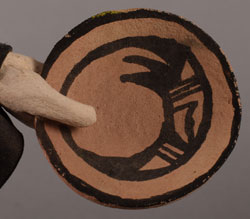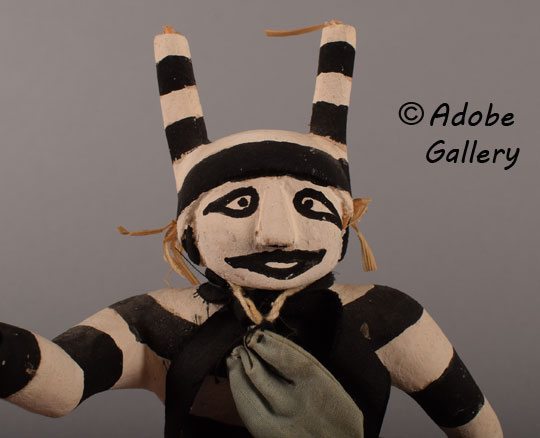Hopi Pueblo Koshare Clown Katsina Doll with Gifts
+ Add to my watchlist Forward to Friend
Forward to Friend
- Category: Traditional
- Origin: Hopi Pueblo, Hopituh Shi-nu-mu
- Medium: wood, paint, fabric, corn husks
- Size: 9-¼” tall
- Item # C4725C
- Price: $1350
The Koshare Clown: A Symbol of Hopi Culture and Humor
This clown is a remarkable representation of the Hopi Koshare, a figure deeply embedded in Hopi culture. This Koshare, a testament to the artistry of its creator, is intricately adorned with a variety of materials, including fabric and string. In a gesture of generosity, he bears gifts for the Hopi people. His left hand clutches a bag filled with presents, while his right hand extends a shallow bowl, an offering to an unseen recipient.

The craftsmanship of the carving is evident in its precision and attention to detail. The Koshare stands upright, though it requires support or can be hung on a wall, much like a traditional katsina doll. While its exact age remains uncertain, it is believed to date back to the 1950s.
The Koshare, one of the most recognized Hopi clowns, traces its origins back to the Tewa Pueblos of New Mexico. It is believed that the Koshare arrived at Hopi with the pueblo immigrants following the Pueblo Revolt, settling in a village atop First Mesa, known today as Hano Village. Despite their Tewa roots, the inhabitants of Hano Village have adopted the Hopi culture and retained their Tewa language, and the Koshare has become a ubiquitous figure in all Hopi villages, even earning a Hopi name.
Interestingly, the New Mexico Tewa people refer to this clown as Koosa, not Koshare. These clowns serve a dual purpose: to entertain and to educate. Their humor often highlights behaviors that deviate from the accepted Hopi way of life. During plaza events, the clowns perform pantomimes that satirize such behaviors. For instance, they might mimic gluttony, using humor to underscore its negative implications. These performances often incite uproarious laughter from the audience, effectively combining entertainment with moral instruction.
Condition: very good condition
Provenance: this Hopi Pueblo Koshare Clown Katsina Doll with Gifts is from a private collection
Recommended Reading:
- Clowns of the Hopi: Tradition Keepers and Delight Makers by Barton Wright
- Kachinas: a Hopi artist’s documentary by Barton Wright
TAGS: Kachina – Katsina Doll, Hopi Pueblo

- Category: Traditional
- Origin: Hopi Pueblo, Hopituh Shi-nu-mu
- Medium: wood, paint, fabric, corn husks
- Size: 9-¼” tall
- Item # C4725C
- Price: $1350
Adobe Gallery Recommended Items
If you are interested in this item, we would also like to recommend these other related items:



